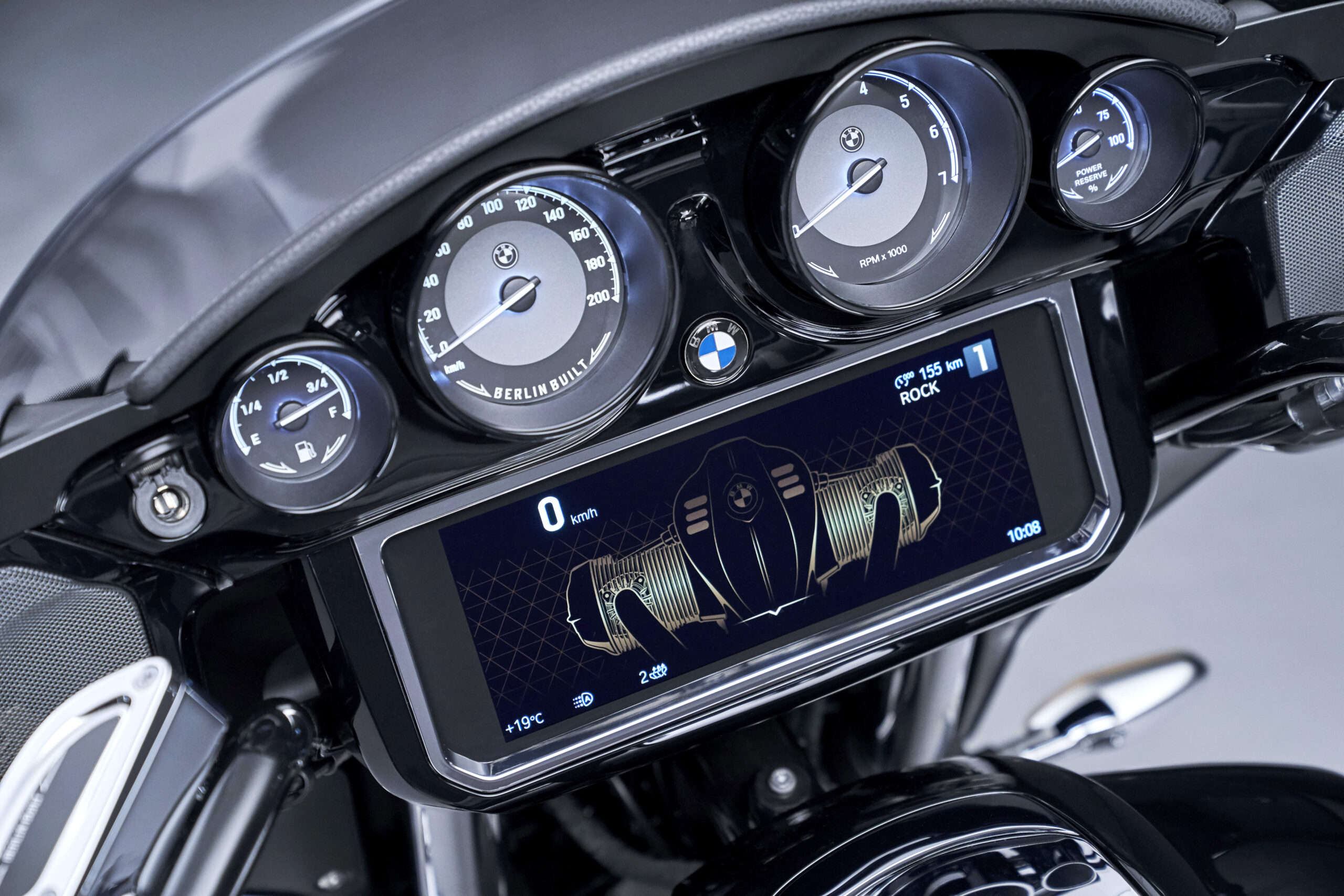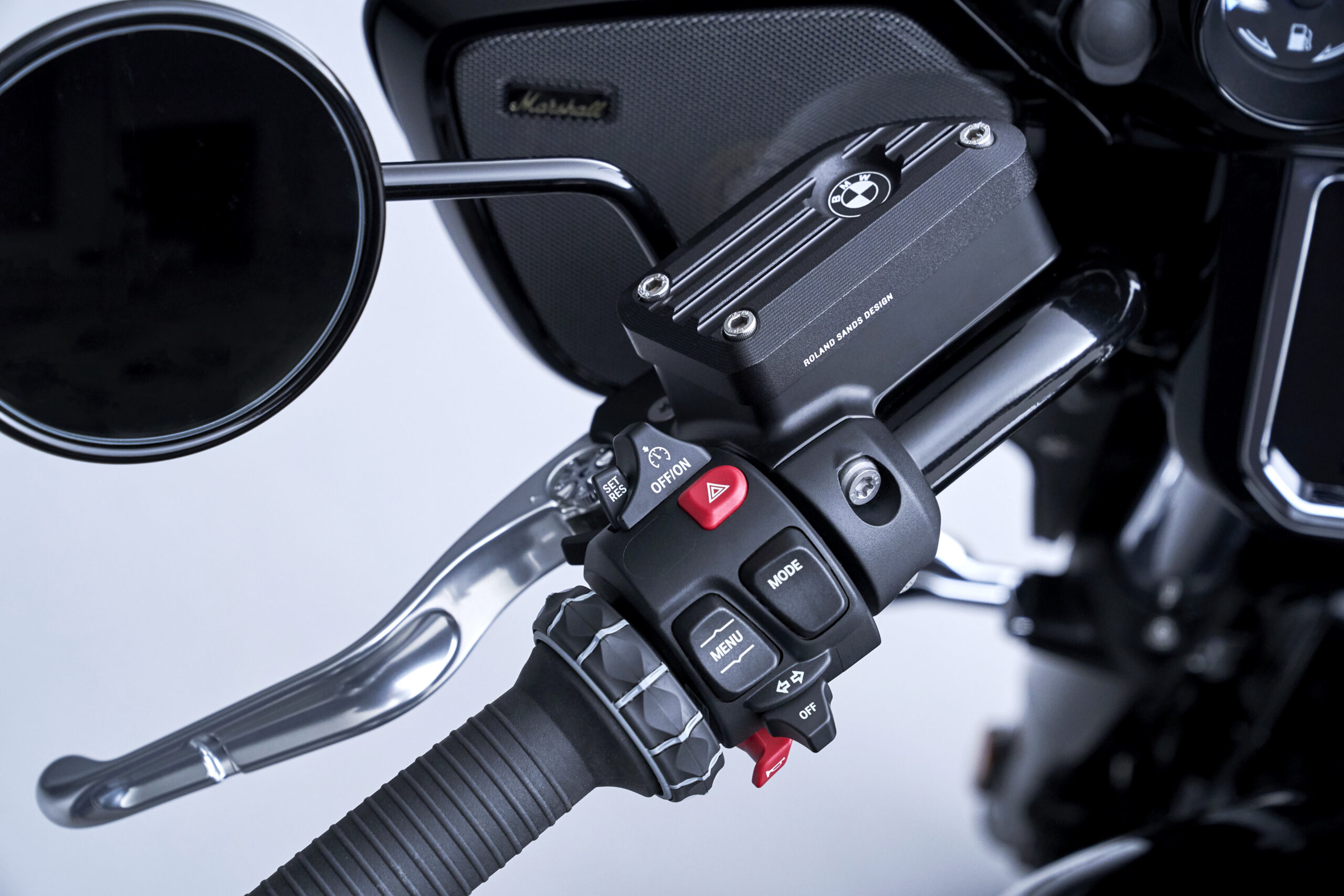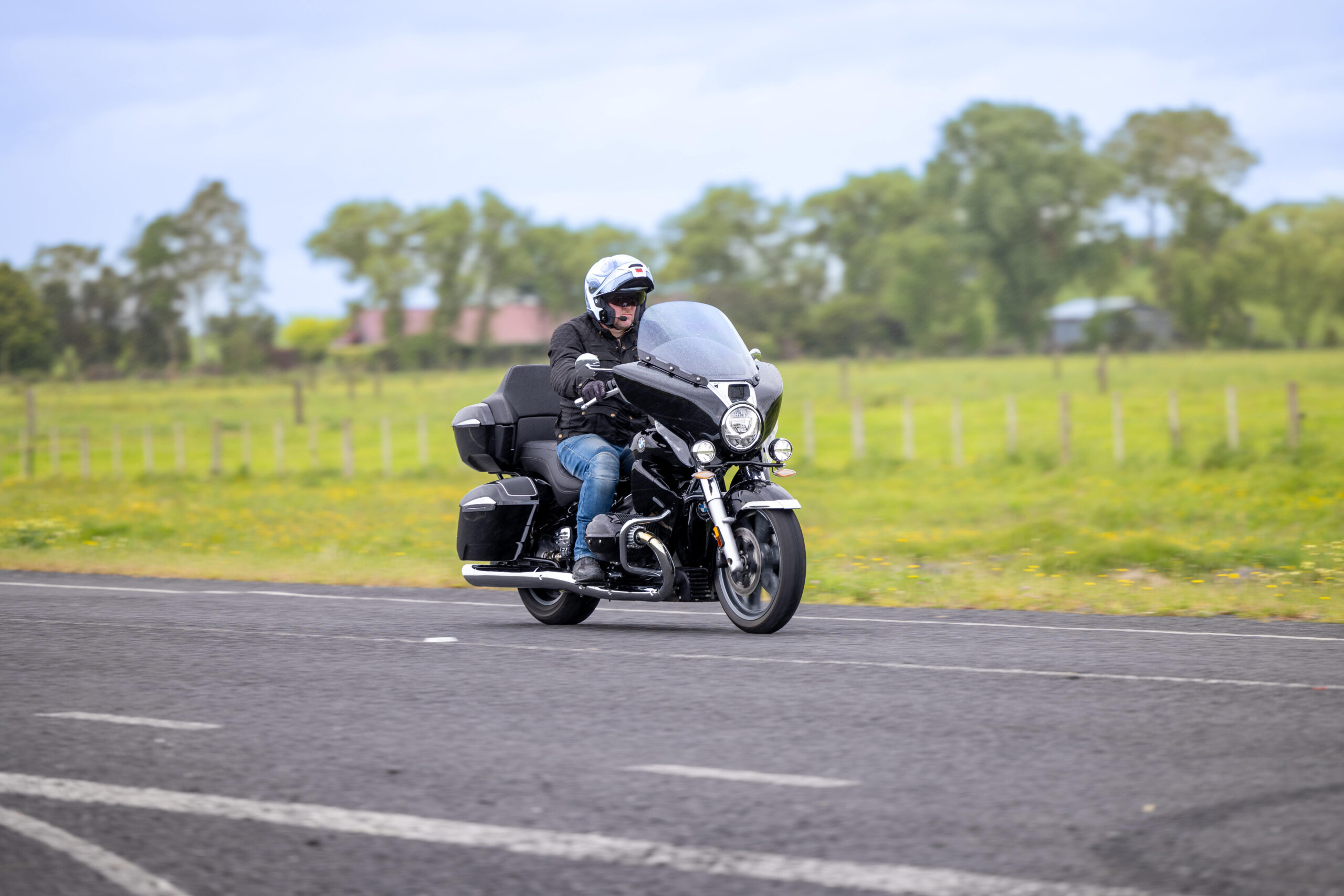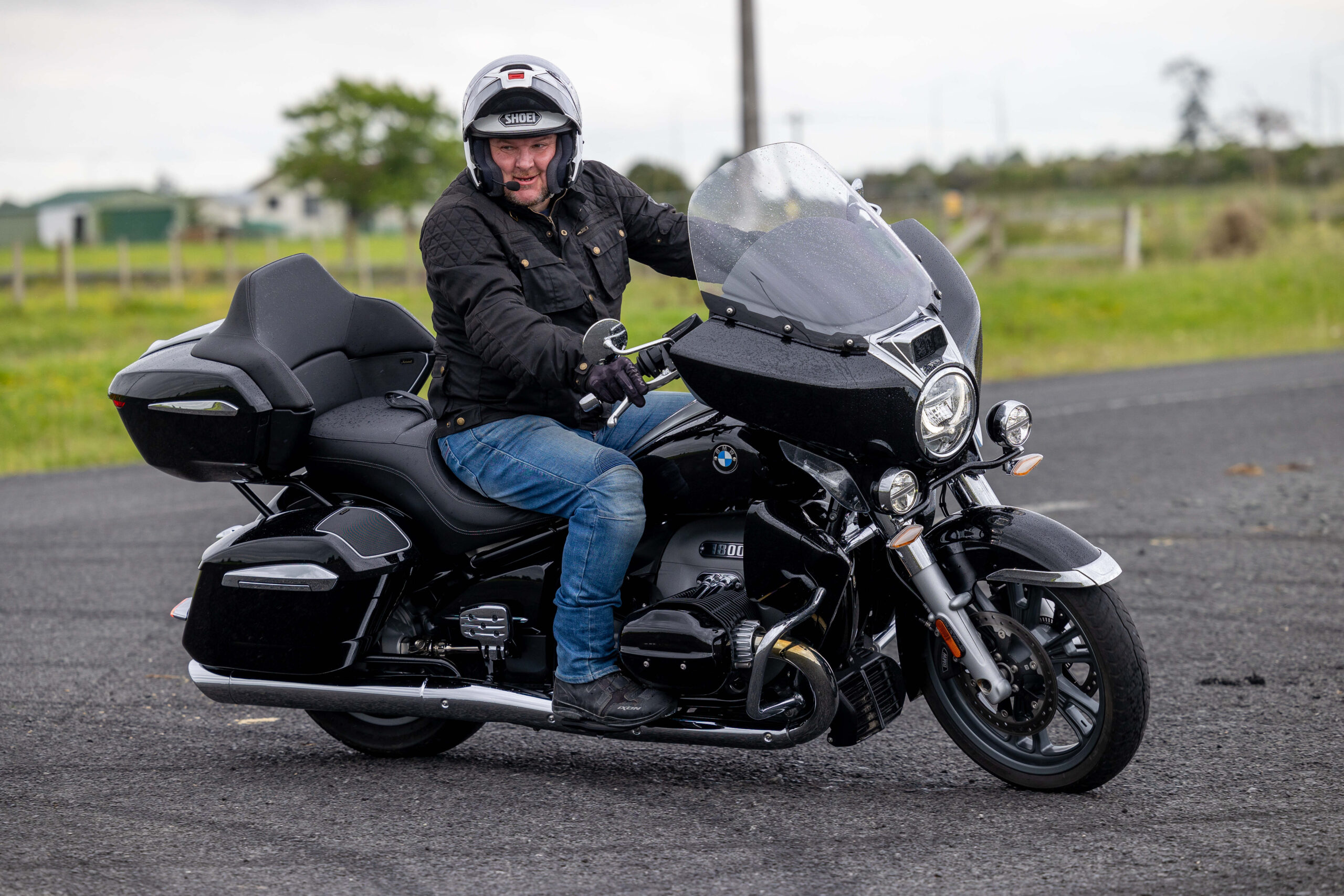Introduction
Opening the BMW R18 Transcontinental’s gargantuan top box and seeing an LED interior light on a stalk lighting up the large space really told me what this bike was all about. Everything is excess – from the 158Nm of torque produced from the 1802cc boxer twin to the 10.25-inch TFT dash and the massive Marshall sound system. Oh, and there’s the dimensions, with the R18TC over 2.6metres long, over a metre wide and slightly over 400kilos ready to ride.
Yep, there’s nothing small or dainty about this motorcycle (which apparently has been particularly popular in the good ol’ U.S of A) apart from maybe the seat height, which thankfully is a comfortable 740mm from the floor, meaning it’s easy to get both boots firmly on the ground.

And that’s important, as it wouldn’t take much stuff shoved into the pannier space and a pillion perched in the sumptuous saddle at the rear to get the R18TC tipping the scales at well over half a tonne in weight. So, if you’re even remotely unsure about balancing a bike or don’t have particularly beefy thigh muscles, then this probably isn’t the machine for you. Even shoving it off what must be the world’s strongest sidestand takes a fair degree of effort.
But thinking of the R18 as an overweight freeway cruiser would be doing it an injustice, as this is a BMW, you know, and the Germans have a knack of making stuff they produce simply work, and the R18 follows in that tradition. Once you’re up and moving, the weight disappears (relatively speaking, as it’s still a hunk of metal you’re attempting to balance on two wheels!), and the massive flat twin comes into its own, especially with 150Nm of torque available from almost zero revs.
Like any premium offering from the Munich massive, the R18 Transcontinental is a seriously good piece of kit that is perfect for what it’s been designed for – cruising in comfort.
BMW R18 Transcontinental: The Best of the Best
I guess when a motorcycle has a price tag above $40k, it’s easy to furnish it with all the goodies. And looking from another perspective, if you’re shelling out your hard-earned cash for a machine of this value, you’re going to expect it to have all the fruit and some.

Picking the bike up from the new BMW-Motorrad HQ at Continental Cars in Auckland, the handover took markedly longer than most bikes, where I’m simply handed the key and told, ‘There you go’. Firstly, the R18 doesn’t have a key, it has a fob that shares the same swollen silhouette as the motorcycle. I guess BMW figured someone who likes a big bike would want a big fob to match.
Hitting a button in the centre of the dash fires everything into life, with the impressive 10.25-inch TFT screen running through a welcome sequence before ending up with a cool picture of the chunk of metal sitting in front of your legs. The fob also has a button on it for the ‘central locking’ – what will they think of next – which locks and unlocks the luggage. And it’s top-shelf luggage at that, with the top box enamouring me with the fact it raises on struts when it opens, meaning you don’t knock the helmet off the passenger seat that you’ve invariably put there.
The interior light I later discovered was a BMW accessory that plugs into the power point inside the case, with BMW sticking to the large powerpoints that then require you to buy something that slots into it to turn it into a USB, for example. Still, it’s an easier location for charging than the other point below your butt by the motor, although the flap that opens on the tank between your legs is especially cool, with wireless phone charging and USB tucked inside. See, told you it had all the fruit…
BMW has been running the same style of menu system on its TFT dashes for a while, with the wheel on the left handlebar perfect for swapping through menus, with a press of a button all that’s required to select something. It’s intuitive and wasn’t something I needed explaining, unlike how to get the big beasty into reverse. Yep, with a bike this big, parking without thinking of your escape route can be an embarrassing experience – no one wants to be that guy who needs to ask for help to be pushed back out of the gutter.
Thankfully, BMW has fitted the R18 TC with a small lever positioned beneath your left knee which, when the bike is in neutral, will select a reverse cog. All you then need to do is hit the starter button and the BMW will begin to move slowly backwards. It’s cool and also a relief when you suddenly realise you’ve parked like a dick.

Despite the classic looks, the BMW is dripping with tech, including a rather nice adaptive cruise control. When you’re situated behind a windscreen big enough to shelter a bus, it’s easy for the speed to creep up, so cruise soon becomes an important part of your riding life – well, it does for me anyway. It’s easy to operate, with a slide and a press of a button activating a green display on the dash showing how close/far the system is set for keeping you away from the vehicle in front. Hit a button on the left, and the lines either add or subtract, enabling you to choose your distance while rocking the lever back and forth increases or decreases speed. It’s a great system and works well, which I’m sure will please those folks in the States.
As is nearly always the case nowadays, you connect an app on your phone to the bike and then the bike to your headset, if you have one. If you don’t, it isn’t really an issue with the R18 TC, as the Marshall sound system is loud enough that you can still hear it clearly at motorway speeds. In fact, it’s so loud you could probably win a speaker battle with any of the local ‘yooof’ who like to drive around at night waking the neighbourhood.
These speakers are seriously loud, something I discovered when I inadvertently had my phone turned up to max and started the bike outside the house. Thankfully it was still on the sidestand as I physically jumped so high I think I left the seat, while our dogs took the rest of the morning to settle down from the shock.
Cali Cruising
Heading out into North Shore traffic isn’t my favourite thing to do, especially on a brand-new bike worth $40+k and 400-kilos, so there was a certain amount of trepidation as I pulled away from BMW. Stalling and toppling over wasn’t something I was keen to try, but I shouldn’t have worried as the R18’s mammoth torque produced so low in the revs makes pulling away and getting up to cruising speed a piece of cake.
And then, somehow, the feeling of mass almost melted away as my speed increased, with the exceptionally low centre of gravity courtesy of the two cylinders positioned low in front of me meant the R18 could almost (and I must impress ‘almost’) feel light to steer, and dare I say, even flickable. Okay, it needs to be taken into context as this is still a seriously big bike, but somehow BMW has managed to make it, well, manageable.

The motor sounds great, with the three maps (Rain, Rock & Roll) changing the characteristics of the delivery and the sensitivity of the throttle. I couldn’t decide between Rock and Roll (I never see the point of Rain), as Roll was nice and easy while Rock upped the throaty sounds from the twin and produced a heap more urgency when opening the taps. But, at least while I was attempting to deal with traffic, navigation and getting to know the bike, Roll was a nicer place to be, with a quick swap to Rock on the fly allowing me to get the most from the epic engine as the traffic opened up.
And it is EPIC! How the usually conservative Germans managed to come up with something so crazy is beyond me, but they’ve done it in a thoroughly German way, with the almost 1-litre pistons never feeling like they want to rattle your fillings out. Instead, the R18 is smooth – unless you really let the revs fall too low – and pulls from 2,000rpm up to about 4,000rpm like there’s a giant hand giving you a big shove. If you want to know what torque is, then this is the bike that demonstrates it best, with the big twin developing 150Nm of torque from 2,000rpm.
Above 4-grand the big pistons begin losing their charm and power tails off, hence the fact there’s only 91hp max at 4,750rpm. But grabbing another cog and getting back into the meat of the power is where the fun is at, with overtakes the most fun as the R18 surges forward.

Yet, while those big pistons are good for torque, I didn’t find them that great for ergonomics, with the fundamental fact there’s a big hunk of cylinder where you ideally want your legs to go means the footboards and levers are set further rearward than felt natural. After a while, I started to get used to it, but at the beginning, I was really struggling to activate the heel/toe shifter properly, having to physically lift my foot up and move it to find the lever.
Thankfully, the R18 isn’t the sort of bike that sees you dancing up and down the gearbox, but I couldn’t help thinking that the positioning was all wrong. And over the other side, the rear brake lever felt almost like it was in the footboard, so didn’t offer much in the way of feel, which is something I was certainly looking for while performing feet-up U-turns on small roads during the photoshoot. I could do it, but just like the gears, it just didn’t seem right. I guess if this was your only bike, you’d get used to it. But jumping on and off, it just felt odd.
More Than Soul
With the American slant of the Transcontinental – essentially, it’s BMW’s attempt at wrestling some cruiser market share from H-D – it would be easy to think that this is a bike designed to go in the straight line and not much else. And to be honest, that was what I was expecting after riding the standard R18, which I found had an awesome powerplant but wasn’t the biggest fan of tackling corners.
Yet, somehow, the Transcontinental far outperformed my expectations when it came to handling the twisties, so much so that I chose the windy route back to Auckland up the western side of the motorway rather than setting the cruise and clicking off the kays.

The fact the engine and all that weight is positioned so low in the frame is the same with both models, but it’s a different frame on the TC, with a double-loop tube and an extra strong backbone there to deal with the extra weight of the tourer. And while both models have the sensibly-sized 180-wide 16-inch rear wheel, the fact they expect you to put a heap of weight on the back of the TC means it gets different suspension and an extra 30mm of height at the rear than the naked cruiser.
And that little bit extra means a whole heap of difference when cranking through the turns, with the Transcontinental more than up to a bit of high-speed cornering. Okay, it doesn’t equate to enough lean angle that you could add the word ‘sports’ in front of the tourer moniker, but it’s certainly enough of an advantage over the R18 cruiser to make it a whole heap more fun and certainly more suitable to Kiwi riding conditions. Added to that is the fact the TC has a slightly shorter wheelbase than the R18 (down from 1,731mm to 1,695mm) and a slightly steeper steering geometry, all of which go to make the tourer a better handler.
With the braking taken care of by BMW-branded four-piston calipers gripping 300mm twin discs, there’s enough power simply using the front to get the big bagger slowed even when carrying a bit more speed than recommended.
And while there’s not much feel from the rear, it’s certainly handy to bring into the equation when your eyes start widening when you realise you’re on a 427-kilo machine probably carrying a bit too much speed for the approaching bend. And, being a modern BMW, there’s a whole heap of electronic aids designed to help out when you have a bit of brainfart, with ABS, traction control and brake torque control all working away in the background.
BMW R18 Transcontinental: Final Test

Working my way back up to the North Shore to drop the BMW back and meet Kerry in the BRM van, I was treated to my final test on the Transcontinental – a bit of good old-fashioned lane splitting. Yep, despite the fact it was mid-morning, the motorway was still grid-locked, and as I approached the wall of brake lights as the three lanes of traffic ground to a stop, I had a momentary thought that maybe the sensible option was to just stop and wait.
But then, what’s the point of riding a motorcycle? And as I’ve lane split on a three-wheeled Yamaha Niken, I was pretty sure the R18TC wasn’t as wide as that, so I breathed in, let the brakes off and slid between the lanes.
And, you know what? The R18 Transcontinental just got on with the job. I needed a quick glance down as, after a few cars, I suddenly panicked that maybe the rear of the bike was wider than the fairing at the front. But once I’d confirmed that if the front got through then the rear was going to follow, I settled into my rhythm of cruising through the traffic.

Obviously, there were points where, say, two trucks were together when the gap simply got too tight, but the torquey motor (which I’d swapped back to Roll) combined with the low c of g, wide ‘bars and decent brakes meant I could balance almost at walking pace while I waited for the gap to open up. And I know they say loud pipes save lives, but I reckon loud stereos are pretty good too, with the Marshal speakers making sure everyone knew I was coming.
The fight through the traffic was the final piece of the puzzle to really endear me to a bike that, if I’m honest, I wasn’t expecting to like that much. The fact the TC looks like it’s designed for the long straight roads of the States led me to think it wouldn’t work in NZ, but discovering it was actually better to ride than the standard R18 blew me away.
Okay, this is not the bike for you if you lack any confidence in your riding or if you’ve got dodgy knees. But if you’re looking for the ultimate ride, one that’s slanted more towards ‘tourer’ than it is ‘sports’ and will certainly make you stand out in a crowd of American machines, then the Beemer is worth a go. It’s typical BMW in that it’s got a few quirks, but fundamentally, it does everything you could want in a no-fuss, clinical way. And while they’ve tried to introduce a bit of character and a bit of mongrel with the sporty map and throaty growl, it’s still got that German feel. And, to be honest, that’s no bad thing.

Pros
- Massive torque from the incredible motor
- Extra cornering ability
- Ultimate stereo
Cons
- Foot position due to cylinders
- Size does matter!
Images by Two Creative Photography













